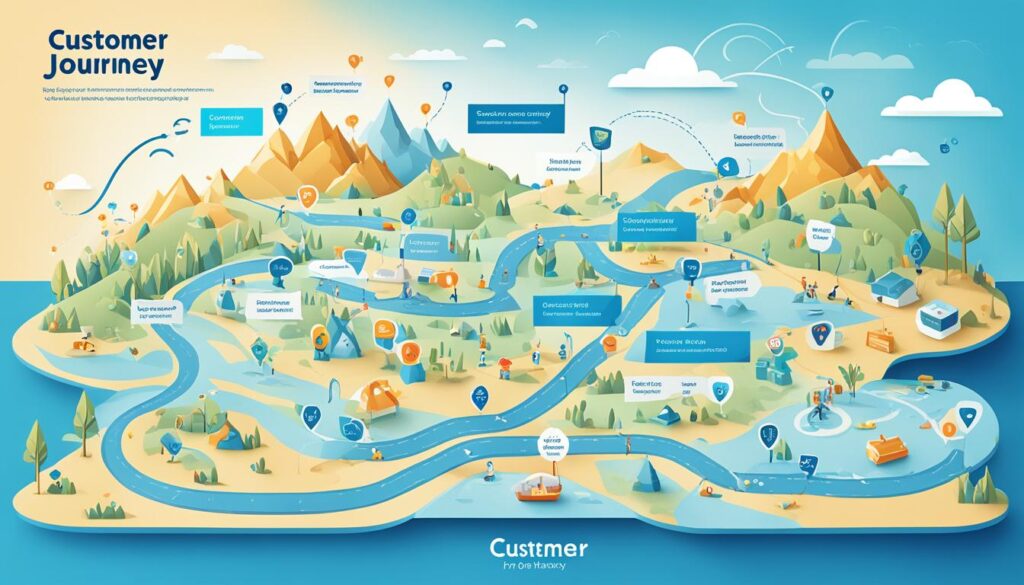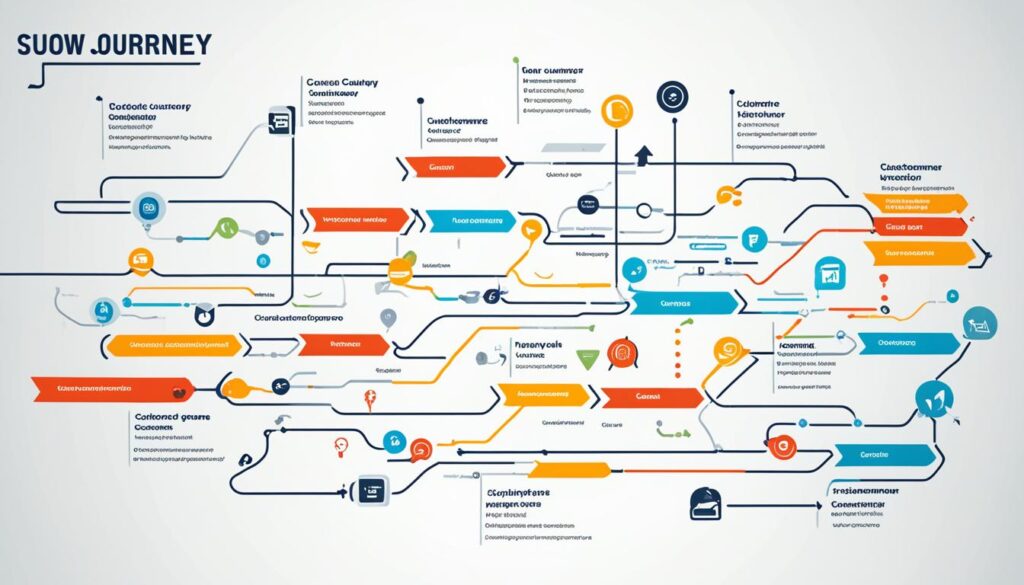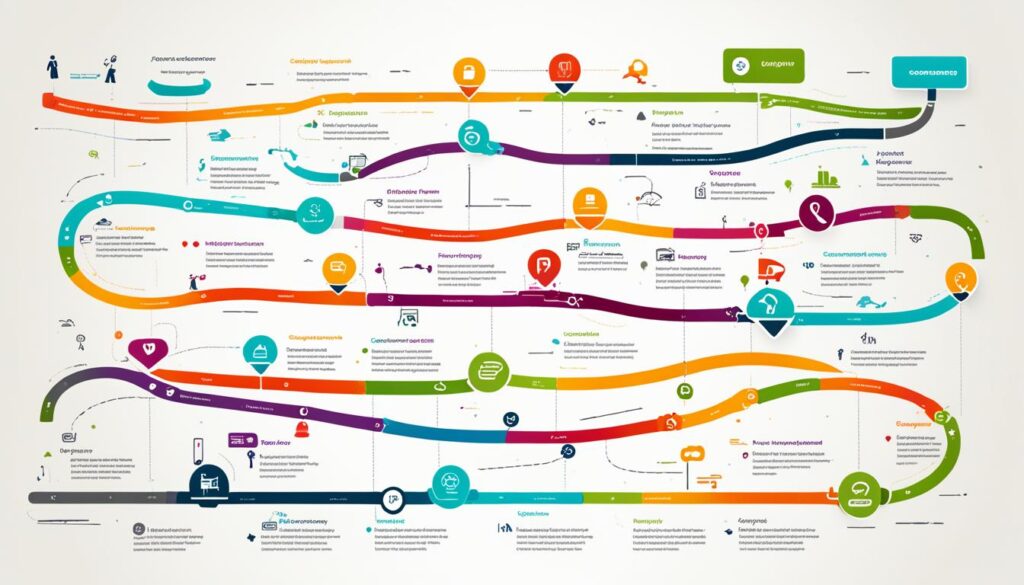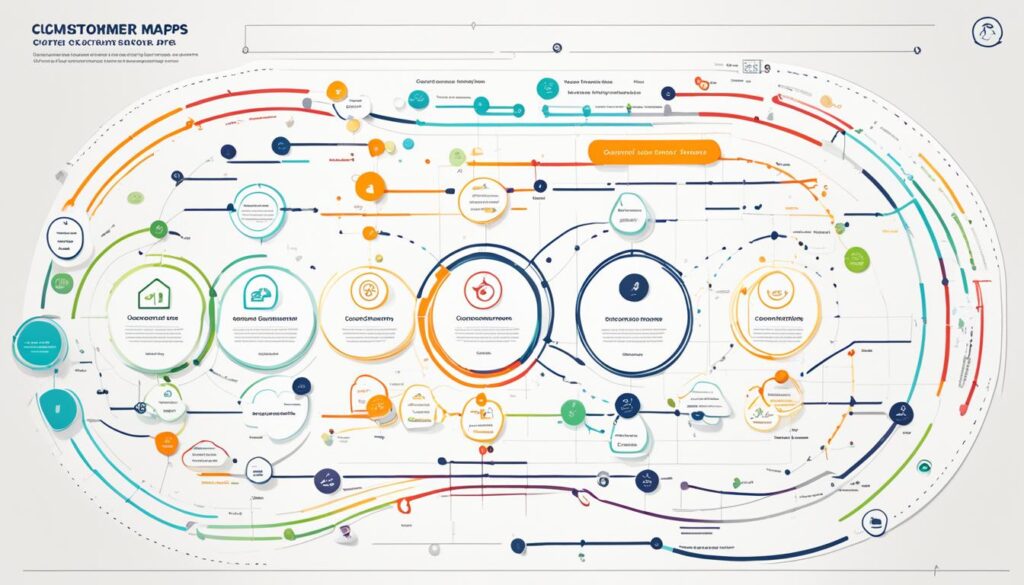Are you looking to enhance your brand experience and increase customer loyalty? Look no further than fantastic voyage customer journey mapping. This innovative approach allows companies like yours to understand and improve the customer experience by analyzing the path customers take when interacting with your brand. Trust us, the effort is well worth it.
Customer journey mapping reveals invaluable insights into customer behaviors, pain points, and areas for improvement, enabling you to create a personalized and impactful experience for your customers. By mapping the customer journey, you can enhance your brand experience, increase customer loyalty, and drive business success. Customers are willing to share information if it leads to better experiences for them.
Remember, high-effort customer experiences can lead to disloyalty and negative word of mouth, while low-effort experiences contribute to customer loyalty. With fantastic voyage customer journey mapping, you can unlock the rewards of an enhanced brand experience and establish long-term customer satisfaction and loyalty.
Understanding the Customer Journey
The customer journey is a crucial aspect of the brand experience. It encompasses every interaction a customer has with your brand, from browsing your website to contacting customer service. By understanding the customer journey, you can gain valuable insights into what your customers love, dislike, and the challenges they may face. These insights can then be used to enhance the customer experience, foster personalized relationships, and drive customer loyalty.
Customer journey mapping is a powerful tool that allows you to visualize and analyze the customer journey. By mapping out the various touchpoints and stages of the journey, you can identify areas for improvement and make informed decisions to enhance the overall brand experience.
When customers have a positive experience throughout their journey, they are more likely to develop a strong bond with your brand. Personalized relationships built through exceptional customer service and tailored experiences can significantly impact customer loyalty. By investing the time and effort into understanding the customer journey, you can create personalized experiences that leave a lasting impression.
Understanding the customer journey and leveraging it to drive customer satisfaction is a key strategy for businesses today. By optimizing each touchpoint and ensuring a seamless experience at every stage, you can create a customer journey that sets your brand apart from the competition.
The Importance of Customer Journey Mapping
Customer journey mapping is a crucial process for businesses looking to improve their customer experience and meet customer expectations. By mapping out the entire customer journey, companies can gain valuable insights into the needs, pain points, and preferences of their customers at every stage of their interaction with the brand.
This information is instrumental in enhancing the customer experience, increasing conversions, and boosting customer retention. By identifying areas of improvement through customer journey mapping, businesses can take proactive steps to address customer pain points and provide a seamless brand experience that meets and exceeds customer expectations.
“Customer journey mapping allows businesses to understand their customers on a deeper level and tailor their strategies accordingly.”
Improving the customer experience is essential for businesses as it directly impacts customer loyalty and satisfaction. When customers have a positive experience, they are more likely to remain loyal to the brand, make repeat purchases, and recommend the brand to others. Moreover, satisfied customers also contribute to increased conversions as they are more inclined to complete their desired actions, such as making a purchase or signing up for a service.
To illustrate the importance of customer journey mapping, consider a scenario where a customer encounters difficulty navigating a website while trying to make a purchase. If this issue remains unaddressed, it could lead to frustration and ultimately result in the customer abandoning their purchase. However, through customer journey mapping, businesses can identify pain points like this and implement improvements to ensure a smooth and seamless customer experience, ultimately increasing conversions.
- Customer journey mapping helps businesses:
- Understand customers on a deeper level
- Meet and exceed customer expectations
- Increase conversions and sales
- Boost customer retention and loyalty

By following customer journey mapping best practices and utilizing the insights gained, businesses can create a customer-centric approach that aligns with their customers’ needs and preferences. By continuously improving the customer experience, businesses can build stronger relationships with their customers and foster long-term loyalty.
Now that we understand the importance of customer journey mapping, let’s delve into the various elements that constitute a customer journey map and how businesses can create their own customized journey maps tailored to their unique customer base.
The Elements of a Customer Journey Map
A customer journey map is a valuable tool for businesses to gain insights into the customer experience. It provides a visual representation of the customer journey, enabling companies to identify pain points, opportunities, and emotions throughout the process. Let’s explore the key elements that make up a customer journey map:
Customer Journey Stages
The customer journey is divided into specific stages, each representing a step that the customer takes towards their goal. These stages help to break down the overall journey into manageable parts, allowing for a detailed analysis of the customer’s interactions with the brand.
Touchpoints
Touchpoints are the various interactions that customers have with a company. These can include visiting a website, making a purchase, contacting customer service, or engaging with the brand on social media. Identifying and understanding these touchpoints is crucial for delivering a seamless and personalized customer experience.
Departments Responsible
A customer journey map also highlights the departments responsible for each stage of the journey. This helps to ensure accountability and collaboration across different teams within the organization. By clarifying responsibilities, companies can streamline processes and deliver a consistent customer experience.
Pain Points and Opportunities
Pain points refer to the challenges or frustrations that customers experience during their journey. By identifying these pain points, companies can address them and find opportunities for improvement. This allows businesses to enhance the customer experience and increase customer satisfaction and loyalty.
Actions and Emotions
Actions and emotions refer to the behaviors and feelings of customers throughout their journey. Understanding these actions and emotions helps companies to design interactions and experiences that resonate with customers on an emotional level. This emotional connection can drive brand loyalty and advocacy.

A well-crafted customer journey map provides a holistic view of the customer experience, allowing businesses to identify pain points, seize opportunities, and create meaningful interactions. By leveraging the insights gained from a customer journey map, companies can optimize their operations, improve customer satisfaction, and drive business growth.
Steps for Creating a Customer Journey Map
Creating a customer journey map involves several steps that will help you gain valuable insights into your customers’ experiences. By understanding their behaviors, preferences, pain points, and opportunities, you can improve their journey with your brand. Follow these steps to create an effective customer journey map:
-
Gather Customer Data: Start by collecting data about your customers’ interactions with your brand. This can include website analytics, customer surveys, and feedback. By gathering this valuable information, you can uncover patterns and trends that will inform your customer journey map.
-
Define Customer Personas: Once you have collected the data, identify different segments of your customer base and create customer personas. These personas represent the characteristics, needs, and expectations of your target customers. By understanding their motivations and goals, you can personalize their journey and provide a more tailored brand experience.
-
Identify Customer Touchpoints: Next, identify the various touchpoints where customers interact with your brand. This can include your website, social media channels, customer service interactions, and more. By mapping out these touchpoints, you can visualize the different stages of the customer journey and understand how customers move from one touchpoint to another.
-
Analyze Pain Points and Opportunities: Take a closer look at each touchpoint and analyze the pain points and opportunities for improvement. Pain points are areas where customers face challenges or frustrations, while opportunities are areas where you can provide better experiences. By identifying these pain points and opportunities, you can make targeted improvements and enhance the overall customer journey.
-
Map Out the Customer Journey: Finally, visualize the entire customer journey by mapping out each stage and touchpoint. Use the insights gathered from the previous steps to create a holistic view of the customer experience. This map will help you understand the customer’s emotions, actions, and expectations at each stage, allowing you to make informed decisions about enhancing their journey.
Creating a customer journey map is a powerful tool that can drive customer satisfaction, loyalty, and business success. By following these steps, you can gain a deeper understanding of your customers and create more personalized and impactful experiences throughout their journey with your brand.

Types of Customer Journey Maps
When it comes to customer journey mapping, there are several types of maps that companies can create to gain insights into the customer experience. Each type focuses on different aspects of the customer journey, allowing businesses to tailor their strategies accordingly.
1. End-to-End Journey Map
An end-to-end journey map provides a holistic view of the entire customer journey, from the first point of contact to the final stage of customer loyalty. It encompasses all touchpoints and interactions, allowing companies to understand the customer experience from start to finish.
2. Specific Touchpoint Journey Map
A specific touchpoint journey map zooms in on a particular touchpoint or interaction with a brand. This type of map focuses on analyzing the customer’s experience at that specific point, such as browsing a website, contacting customer service, or making a purchase. By understanding the customer’s perspective at these critical moments, companies can optimize the touchpoints for better customer satisfaction.
3. Channel-Specific Journey Map
A channel-specific journey map examines the customer journey within a specific channel or platform. For example, companies can create a journey map specifically for social media interactions or the online shopping experience. This type of map allows businesses to identify pain points and opportunities unique to each channel and optimize the customer experience accordingly.
4. Service Blueprint
A service blueprint goes beyond the customer journey and includes the behind-the-scenes processes and systems that support the overall customer experience. It maps out the entire service delivery process, highlighting the interactions between different departments and systems involved in delivering a seamless customer experience. Service blueprints help companies identify potential bottlenecks and areas for improvement in their internal processes.

By using different types of customer journey maps, companies can gain a comprehensive understanding of the customer experience, identify pain points, and uncover opportunities for improvement. These maps serve as valuable tools for optimizing the customer journey, enhancing the brand experience, and ultimately driving customer loyalty and satisfaction.
Best Practices for Customer Journey Mapping
When creating a customer journey map, there are several best practices to keep in mind. By following these customer journey mapping best practices, you can ensure that your map is effective and aligned with your business goals.
- Tie the map to your specific business goals: It’s important to have a clear understanding of what you want to achieve through customer journey mapping. By aligning your map with your business objectives, you can focus on areas that will have the greatest impact on your bottom line.
- Involve cross-functional teams: Customer journey mapping is a collaborative effort. By involving representatives from different departments, you can gain diverse perspectives and expertise. This interdisciplinary approach helps to ensure that all touchpoints and pain points are considered and addressed.
- Base the map on customer personas: Customer personas represent different segments of your customer base. By creating maps specifically tailored to each persona, you can develop a customer-centric approach. This allows you to better understand the unique needs, preferences, and pain points of each customer segment.
- Use customer feedback to inform and validate the map: Customer feedback is a valuable source of information when creating a customer journey map. It provides insights into customer experiences, pain points, and opportunities for improvement. Incorporating customer feedback into your map ensures that it accurately reflects the realities of the customer journey.
- Iterate and refine the map: Customer journey mapping is an ongoing process. As customer needs and expectations evolve, it’s important to continuously refine and update your map. Regularly reviewing and analyzing your map helps to identify areas for improvement and ensures that the map remains accurate and relevant.
By following these customer journey mapping best practices, you can create a comprehensive and effective map that enables you to understand and improve the customer experience. Remember, customer journey mapping is a dynamic process that requires continuous attention and refinement to truly unlock its full potential.
Conclusion
Customer journey mapping is a fantastic voyage that is well worth the effort for any business looking to enhance their brand experience and increase customer loyalty. By diving deep into the customer journey, companies gain valuable insights that can shape and transform their customer experiences. Understanding the different touchpoints and stages of the customer journey allows businesses to identify pain points and opportunities for improvement, ensuring that every interaction with the brand is seamless and engaging.
Investing in customer journey mapping not only helps businesses meet and exceed customer expectations, but also drives long-term customer satisfaction. By tailoring experiences based on customer preferences, needs, and desires, companies create a more personalized approach that resonates with their target audience. This level of customization enhances the brand experience, cultivating a stronger emotional connection with customers and ultimately increasing their loyalty.
Through customer journey mapping, businesses can unlock the secrets to crafting remarkable customer experiences that leave a lasting impression. By mapping out each stage of the journey, companies can identify pain points and address them proactively, resulting in smoother interactions and increased customer satisfaction. Additionally, by consistently monitoring and refining the customer journey map, businesses ensure that they stay up-to-date with changing customer needs and preferences, maintaining their competitive edge in the market.
Investing time, effort, and resources into customer journey mapping is a strategic move that can yield significant returns for businesses. By enhancing the brand experience and fostering deeper connections with customers, businesses are able to create a loyal customer base that not only continues to support the brand but also becomes vocal advocates for it. In the quest to achieve business success, customer journey mapping is an essential tool that guides companies towards creating memorable, seamless, and impactful experiences that customers will cherish.
FAQ
What is customer journey mapping?
Customer journey mapping is a way for companies to understand and improve the customer experience by analyzing the path that customers take when interacting with a brand.
Why is customer journey mapping important?
Customer journey mapping is important because it helps businesses understand their customers, meet their expectations, and improve the customer experience.
What elements are included in a customer journey map?
A customer journey map includes customer journey stages, touchpoints, departments responsible, pain points and opportunities, and actions and emotions.
What are the steps for creating a customer journey map?
The steps for creating a customer journey map include gathering customer data, defining customer personas, identifying customer touchpoints, analyzing pain points and opportunities, and mapping the customer journey.
What are the types of customer journey maps?
The types of customer journey maps include end-to-end journey map, specific touchpoint journey map, channel-specific journey map, and service blueprint.
What are the best practices for customer journey mapping?
The best practices for customer journey mapping include tying the map to specific business goals, involving cross-functional teams, basing the map on customer personas, using customer feedback, and iterating and refining the map over time.
How can customer journey mapping enhance the brand experience?
Customer journey mapping can enhance the brand experience by improving the customer experience, increasing customer loyalty, and driving business success.
